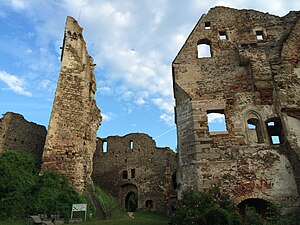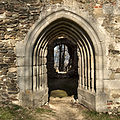Schaunberg castle ruins
| Schaunberg castle ruins | ||
|---|---|---|
|
Schaunberg ruins - keep and hall |
||
| Alternative name (s): | Schamberg, Schaumburg, Schaumberg, Schaunburg | |
| Creation time : | around 1150 | |
| Castle type : | Hilltop castle | |
| Conservation status: | ruin | |
| Standing position : | Count | |
| Place: | Hartkirchen | |
| Geographical location | 48 ° 20 '31 " N , 13 ° 58' 37" E | |
|
|
||
The Schaunberg castle ruins (also Schaumberg , Schaumburg and Schaunburg ) are located in the village of Schaumberg in the Hartkirchen municipality , Eferding district in Upper Austria . It was the ancestral seat of the Counts of Schaunberg and the seat of the County of Schaunberg .
Today's ruin of the Höhenburg was the largest castle complex in Upper Austria . The ruin can be visited, the keep was accessed by a newly built staircase.
history
Name Schaunburg
The name is derived from the view ("look from the mountain"). In addition, the designation Schaunb u rg is used even in official map series (such as the Austrian map 1: 50,000) . Hartkirchen is also officially called Schaunb u rggemeinde . The spellings Scha m b e rg and Schau m burg , which can also be found in the name of the Schaumberg district where the castle ruins are located, are also historically documented . These old spellings also correspond to the pronunciation in the Hausruckviertel dialect, which is still common today , namely Schamberg or Schamburg for the castle ruins and Schamberger for the former count family.
History of the Schaunberger
The Schaunbergers came from the noble von Julbach family and were related in the female line to the Counts of Formbach-Vichtenstein . They had received the toll to Aschach an der Donau from Emperor Barbarossa , a very lucrative imperial fief . In the middle of the 12th century, Heinricus de Scovenberch had a castle built about an hour's walk from Aschach.
In a document from 1316, the Schaunbergers describe themselves as counts and sought imperial immediacy for their county of Schaunberg . Duke Rudolf IV, however, encouraged his follower Eberhard von Wallsee to build a second castle ( Burg Oberwallsee ) across the Danube, across from Schaunberg Castle .

The Schaunberger feud
In 1380 Reinprecht II moved from Walsee on behalf of Duke Albrecht III. against Heinrich von Schaunberg . Although the Schaunberger had allied himself with the Rosenbergers and their ministerials , in the first two years of the "Schaunberger Feud" the Wallsee occupied all of their Danube castles and their town of Eferding . However, he besieged Schaunberg Castle in vain. Since the Rosenbergs did not support him, Heinrich had to submit to the Habsburgs .
In 1388 Wallsee and Habsburg received feuding letters again , and two years later Heinrich von Schaunberg had to finally swear an original feud . But the "talking gargoyles" on the tower of his Neuhaus castle made it clear what he thought of Habsburg and Wallsee.
In 1548 the Schaunbergers lost their imperial estate , in 1559 they died out. At the beginning of the century they had already moved into Eferding Castle, which they had built . After them, their heirs, the Starhembergers, resided here .
Castle complex of Schaunberg Castle
With an area of 17,500 m², it was the largest castle complex in Upper Austria. The castle began to fall into disrepair in the second half of the 17th century.
The core of the system is of a ring wall surrounded main castle . In this there are the remains of the highly visible 32 meters high the keep , the representative Palas , the castle chapel and other outbuildings.
Keep
The keep is free, just behind the castle wall. Its floor plan is pentagonal, the sharp edge of the wedge-shaped tower points in the specified direction of attack. A distinction can be made between two construction phases:
- The bottom five floors date from the middle of the 13th century. The wall thickness on the bottom floor is 350 cm. All interiors are square, which results in a wall thickness of up to eight meters on the wedge side. From the first floor onwards, the keep tapers slightly on the outside. The wall thickness from the fifth floor is about 200 cm. The high entrance was at the rear of the tower, about ten meters above courtyard level.
- In the 14th century the tower was given a further three floors.
The total height is 32 meters, making it probably the most powerful keep in Austria.
In 1825 the northern part of the keep was completely demolished, with the falling rubble also damaging the hall opposite. The preserved half of the tower is now well secured and accessible via a steel stair construction with 189 steps.
Weir systems
Four moats and two drawbridges with an outer and an inner gate were used to protect the castle .
To the west, the castle was by a moat wall around a bailey extended. The western wall was the most vulnerable point of the fortification and was therefore expanded to five meters thick. The wall was flanked by two corner towers and had a keep in the middle. While the corner towers have collapsed completely, a ruin of this second keep still exists.
Hall
Among other things, a Gothic archway has been preserved from the Palas , a representative hall building .
photos
literature
- Maximilian Fuchs: Schaunberg Castle. A representation of the past and the present. Schaunbergfreunde Association, Eferding 1962.
- Otto Wutzel : The Schaunberg Castle. Location, name, history, building description. 3. Edition. Schaunbergfreunde Association, Eferding 1994.
Web links
- Entry about the Schaunberg castle ruins in the scientific database " EBIDAT " of the European Castle Institute
- Entry over the Schaunberg castle ruins to Burgen-Austria
- History of Schaunberg Castle
- The keep of Schaunberg on burgseite.com
- Video about the castle
Individual evidence
- ^ Entry on the Schaunberg castle ruins in Burgen-Austria , accessed on December 2, 2013.
- ^ Entry about the Schaunberg castle ruins in the scientific database " EBIDAT " of the European Castle Institute, accessed on December 2, 2013.













